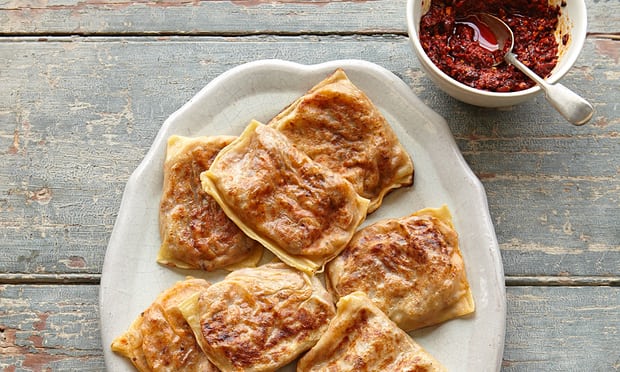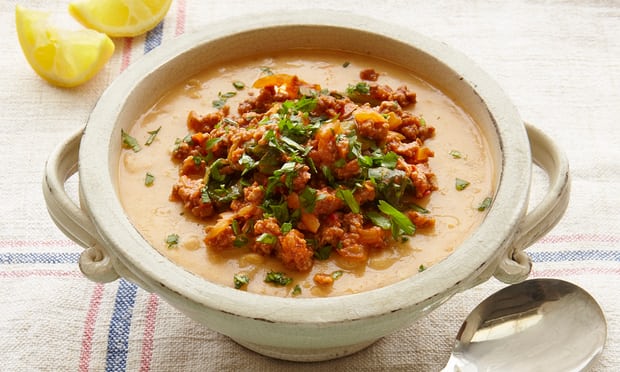Hot stuff: Yotam Ottolenghi's harissa recipes
Of all the chilli sauces in all the world, it's the North African harissa I turn to most often. And it's even better if homemade

Yotam Ottolenghi's spicy Tunisian savoury pastries: 'The filling is lovely by itself with rice.' Photograph: Johanna Parkin for the Guardian. Food styling: Maud Eden
Malaysian sambal oelek, American Tabasco, Thai sriracha, Korean gochujang, Mexican luchito smoked chilli paste: there are enough savoury chilli sauces out there for even this fast-track-to-big-flavour avenue to feel a little crowded. The Mexican luchito, for example, is sweet and garlicky, and made oily by the addition of dark agave nectar; gochujang is a savoury and relatively mild paste of chilli and fermented soybeans; and, with its sharp blend of chillies, vinegar and salt, a little goes a long way with Louisiana's Tabasco sauce.
My favourite of all the chilli sauces, however, is the potent North African harissa. I use it in all sorts: for marinading meat and fish, for mixing with sweet roast carrots, for swirling through a root vegetable or garlic soup, or just for serving with couscous or rice. There's a huge range of ready-made harissas, but homemade is even more delicious, and satisfying, too; it means you get to control its heat levels.
Harissa
Use preserved lemon or rose petals and rose water here: the lemon will make the end result more astringent, whereas the rose softens the kick a little. Makes one small jar, which will keep in the fridge for at least a couple of weeks.
- 5 large red chillies
- 1 large dried ancho chilli
- 2 dried chipotle chillies
- 2 tsp urfa chilli flakes (or ½ tsp regular chilli flakes)
- ½ tsp cumin seeds, toasted and crushed
- ½ tsp caraway seeds, toasted and crushed
- 1 garlic clove, peeled and crushed
- 1½ tsp sherry vinegar
- 2 tbsp sunflower oil
- Salt
- ¾ tsp finely chopped preserved lemon skin, or ½ tsp rose petals and ¼ tsp rose water
Heat the oven to 220C/425F/gas mark 7. Put the fresh chillies on a small baking tray and roast for 10 minutes, until soft and the skin is blistering. Remove, tip into a small bowl and cover with cling-film. When cool, peel the chillies and discard their skin, then put the flesh and seeds in the small bowl of a food processor.
Meanwhile, put the ancho and chipotles in a small bowl, cover with boiling water, set aside for half an hour, then remove and discard the stalks and seeds. Add the chilli flesh to the food processor with the urfa chilli, cumin, caraway, garlic, vinegar, oil, an eighth of a teaspoon of salt and the preserved lemon or rose petals and water. Blitz to a smooth paste (you may need to scrape down the bowl a few times), transfer to a clean jar, seal and refrigerate.
Spicy Tunisian savoury pastries
You'll need to indulge in a bit of method acting when working with such a thin pastry. Just imagine you are Tunisian, and seasoned in the art of stretching dough, and work as quickly as you would if running a busy restaurant, and all will be fine. If you're not in pastry-making-method-acting mode, however, just use filo instead. And if you want to dispense with the pastry altogether, the filling is lovely by itself with rice or bulgur wheat. Serves four.
-
1 medium onion, peeled and quartered
1 large carrot, peeled and cut into chunks
2 large celery sticks, cut into chunks
50g coriander, leaves and stems
3 tbsp olive oil
1 tsp ground cumin
1 tsp ground coriander
1½ tbsp tomato paste
2 tbsp harissa
1 medium plum tomato, coarsely grated (the skin will be left behind)
Salt
1 tbsp lemon juice
80g good-quality tinned tuna (optional)
30g pitted Kalamata olives, chopped
360g fine semolina
80ml sunflower oil, plus extra for greasing hands and work surface
Put the onion, carrot, celery and coriander in a food processor and blitz to a rough paste. Heat the olive oil in a large saute pan on a medium-high flame, then fry the vegetable paste for 15 minutes, stirring a few times, until there is no liquid left in the pan and the vegetables are soft. Add the ground cumin and coriander, tomato paste, harissa, grated tomato, a third of a teaspoon of salt and 90ml water. Cook for five minutes, until the soft red paste starts to caramelise, then remove from the heat. Once cooled to room temperature, stir in the lemon juice, tuna (if using) and olives.
Put the semolina in a medium bowl with a teaspoon of salt. Pour over 250ml water and mix to combine into a sticky dough. Transfer to a food mixer with the dough hook and work on a high speed for eight to 10 minutes, until smooth. Lightly brush your hands and work surface with oil, then roll the dough into a thick sausage. Cut it into eight equal segments and roll each into a ball. Transfer to a lightly-oiled baking tray, cover with cling-film and leave to rest for 10 minutes.
It's much easier if you have a spare pair of hands for this next stage, so that one of you can be rolling and stuffing while the other is frying the pastries, but you can also make them in advance and keep them in the fridge on a parchment-lined tray. Take one ball and, using your oily hands, stretch it out into a 10cm x 5cm rectangle. Lay this on the oiled work surface and continue to stretch out into an almost see-through paper-thin 15cm x 20cm rectangle. Trim and discard the thicker edges, so you're left with a roughly 10cm x 15cm rectangle. Spread an eighth of the filling over the pastry, starting at one of the short edges and keeping it 1cm clear from the edge, and stop when you reach the centre; you want half your pastry evenly covered, with a 1cm rim around the edge. Fold the unspread half of pastry over the filling to enclose, then gently press together the edges to seal. Trim so you have a nice rectangular parcel, but don't worry unduly if the pastry isn't perfect and breaks a bit in a few places; it's all part of the homemade rustic charm. Repeat with the remaining dough.
Put a large nonstick frying pan on a medium heat with two teaspoons of oil. Once hot, fry two or three pastries at a time for three minutes, turning once halfway through, until golden brown on both sides. Remove and set aside while you continue with the remaining pastries, adding oil as needed. Serve at once, hot from the pan.
Gram flour soup with spiced lamb

Yotam Ottolenghi's gram flour soup with spiced lamb. Photograph: Johanna Parkin for the Guardian. Food styling: Maud Eden
- Serves four.
- 4 tbsp olive oil
- 1 medium onion, peeled and roughly chopped
- 2 large red chillies, deseeded and finely chopped
- ½ tsp smoked paprika
- 1½ tsp sweet paprika
- 1½ tsp ground ginger
- 400g lamb mince
- 2 tbsp tomato paste
- 1 tsp caster sugar
- 1 tbsp rose (or regular) harissa
- 20g preserved lemon skin, finely chopped
- 100g baby spinach
- 240g cooked chickpeas (tinned are OK)
- 80g gram flour
- 500ml chicken stock
- 2 long strips lemon zest
- 1 tbsp lemon juice
- 15g coriander leaves, chopped
Heat three tablespoons of olive oil in a large saute pan on a medium-high flame. Once hot, fry the onion and chillies for eight minutes, stirring once or twice, until soft and golden brown. Add the smoked paprika, a teaspoon of sweet paprika, a teaspoon and a half of cumin, a teaspoon of ginger and all the lamb, and fry for three minutes, stirring constantly so the meat breaks up.
Stir in the tomato paste, caster sugar, harissa, preserved lemon skin, three-quarters of a teaspoon of salt and 300ml water, and cook down for three minutes, until the liquid has reduced by a third. Remove the pan from the heat, stir in the spinach and set aside somewhere warm.
While the lamb is cooking, put a large frying pan on a high heat with the remaining tablespoon of olive oil, the remaining spices and a quarter-teaspoon of salt. Once the spices start to sizzle, add the chickpeas and fry for three minutes, stirring occasionally and crushing some with the back of the spoon, until they start to brown. Take off the heat and set aside.
Put the gram flour in a bowl with half a teaspoon of salt and 150ml water, and whisk to a thick paste. Put a medium saucepan on a high heat and add the stock, 350ml water and the shaved lemon skin. Bring to a boil, turn down the heat to medium and add three tablespoons of the liquid to the chickpea flour paste, whisking it in well. Slowly add the paste to the simmering pan, whisking constantly, and cook for a minute or two, until silky-smooth and thick. Remove from the heat and stir through the chickpeas.
Divide the hot soup between four large bowls and spoon the lamb mince on top. Drizzle with lemon juice, sprinkle with coriander and serve at once.
• Yotam Ottolenghi is chef/patron of Ottolenghi and Nopi in London.